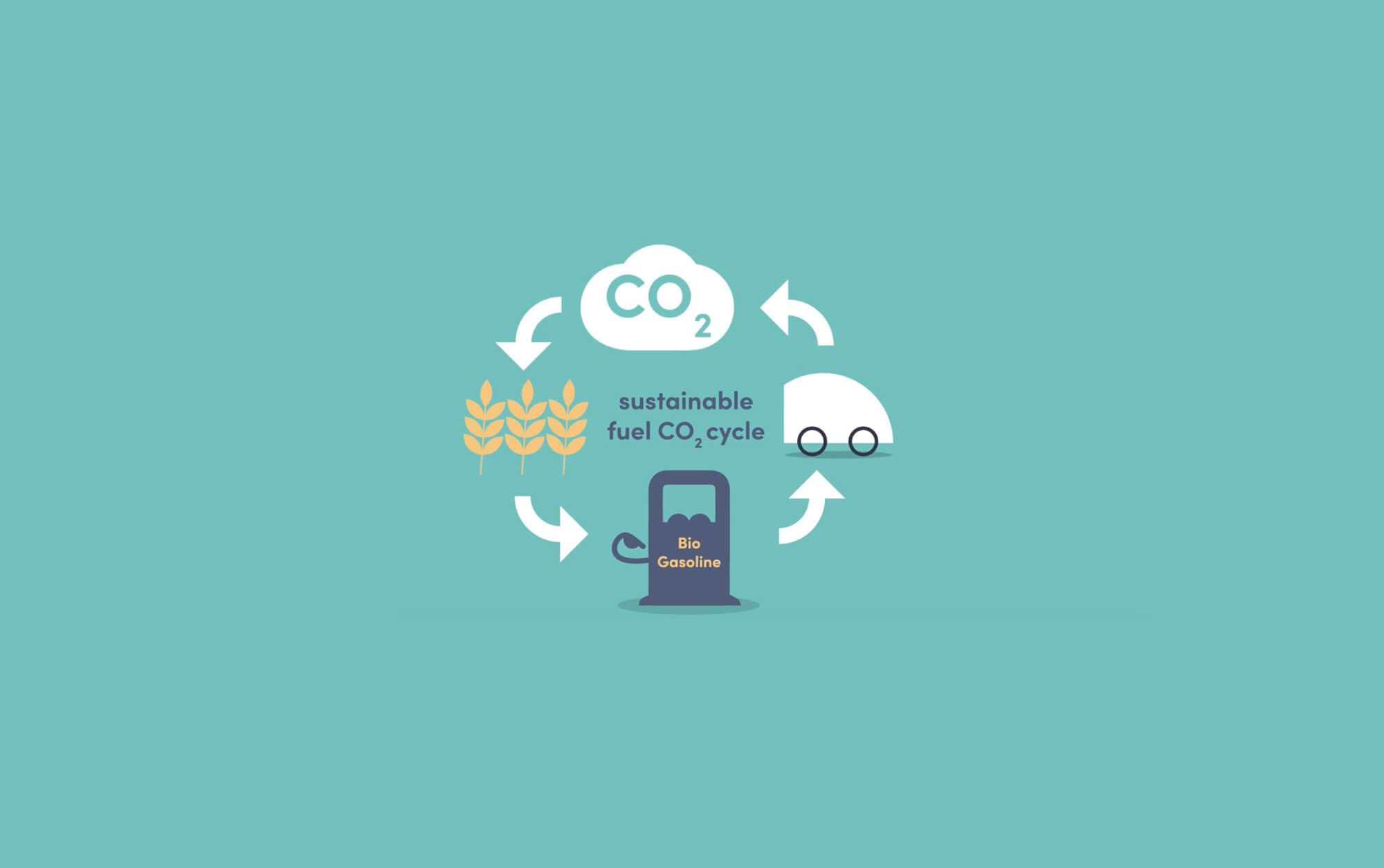
18 April 2023
Glossary – What are the different types of sustainable fuels?

Misunderstandings about sustainable fuels can often occur due to the misuse or confusion of related terms. Therefore, it is important to understand the differences between the various types of sustainable fuels. By gaining a clearer understanding of these terms, we can better appreciate the potential benefits and drawbacks of each sustainable fuel type.
‘Sustainable fuels’
The collective term for all types of sustainable fuel.
Types of sustainable fuel
01
Biofuels
Made by fermentation of plant-based material, hydrotreatment or esterification of plant-based oils.
• 1st generation: use crops as source of biomass
• 2nd generation: use waste as source of biomass
• 3rd generation: use microorganisms as source of biomass
02
Synthetic fuels
The set of hydrocarbon fuels made using CO, CO2 and hydrogen via syngas and Fischer-Tropsch type processes.
• CO/CO2 sourced from industrial processes, biomass or direct air capture
• Hydrogen source is critical
03
Recycled carbon fuels
Recycled carbon fuels (RCFs) are fuels produced from fossil wastes that cannot be avoided, reused or recycled.
Feedstocks include industrial waste gases and the fossil-derived fraction of municipal solid waste (e.g. non-recyclable plastic).
biofuels
Biofuel processes and products
Fermentation
Bioethanol:
Ethanol made from biomass and meeting the requirements of EN15376, the standard for ethanol that can be mixed with petrol in pump fuel. Currently blended into pump gasoline at up to 5% (98RON E5) or 10% (95RON E10). Higher blend ratios are also possible such as E85.
ETG: Bioethanol further processed to produce biogasoline which is functionally equivalent to fossil-derived gasoline meeting EN228, the standard for pump petrol/gasoline available on the forecourt.
Biomethanol:
Methanol made from biomass feedstocks. It can be blended in with gasoline or used directly as a renewable fuel.
MTG: Biomethanol further processed to produce biogasoline which is functionally equivalent to fossil-derived gasoline meeting EN228.
Hydrotreatment
HVO (hydrotreated vegetable oil): A paraffinic diesel very similar to fossil diesel but made by the hydrotreatment of vegetable oils or other lipids, which have to meet the requirements of EN15940, the standard for fossil-free paraffinic diesels for use in road vehicles. They also have the benefit of being sulphur-free.
Can be blended with FAME to create a renewable diesel that meets EN590, the standard for pump diesel available on the forecourt.
Esterifcation
Used to make pure biodiesel by esterification of vegetable oils, typically meeting the requirements of EN14214, the standard for fossil-free fuel made from methyl esters. Also known as FAME or biodiesel, it is not a direct replacement for fossil diesel (lower energy density) but is currently blended in pump diesel at up to 7% (B7).
Can be blended with HVO to create a renewable diesel that meets EN590.

Synthetic fuels
Synthetic fuel processes and products
Gas-to-Liquid (GtL)
These are all synthetic fuels, made using CO, CO2 and hydrogen via syngas (from gasification) converted to a liquid hydrocarbon through industrial processes such as Fischer-Tropsch (FT).
• Renewable sources include syngas from the gasification of pure biomass (which could also be termed BtL, see below), direct air capture, industrial waste gases
• Fossil fuel sources include: natural gas/gasified coal or recycled carbon fuel.
Gas-to-Liquid (GtL)
These are all synthetic fuels, made using CO, CO2 and hydrogen via syngas (from gasification) converted to a liquid hydrocarbon through industrial processes such as Fischer-Tropsch (FT).
• Renewable sources include syngas from the gasification of pure biomass (which could also be termed BtL, see below), direct air capture, industrial waste gases
• Fossil fuel sources include: natural gas/gasified coal or recycled carbon fuel.
Biomass-to-Liquid (BtL)
A specific form of GtL that derives its CO2 from gasification of biomass – this does not make it a biofuel.
Power-to-Liquid (PtL)
A fuel produced using renewable electricity and sources of carbon to produce fuels through synthesis methods described above.
E-fuel
A specific subset of synthetic fuels made using green hydrogen e.g. hydrogen made using renewable electricity to electrolyse water rather than hydrogen derived from fossil sources.
For more related key terms for renewable and low carbon road transport fuels see the glossary below:
Liquid fuels
| Term (and acronym) | Meaning |
|---|---|
| 1G (First generation) | Term describing biofuels that are produced from crops that can be used as food or feed e.g. sugar, starch or oil crops |
| 2G (Second generation) | Biofuels that are manufactured from non-food biomass |
| 3G (Third generation) | Biofuels that are derived from microorganisms like algae |
| B10 | A blend of up to 10% biodiesel / FAME (meeting BS EN 14214) with the remainder petroleum diesel (meeting BS EN 590) which when combined typically meet BS EN 16734 |
| B100 | Pure biodiesel/FAME, typically meeting the requirements of BS EN 14214 |
| B20 | A blend of up to 20% biodiesel / FAME (meeting BS EN 14214) with the remainder petroleum diesel (meeting BS EN 590) which when combined typically meet BS EN 16709 |
| B30 | A blend of up to 30% biodiesel / FAME (meeting BS EN 14214) with the remainder petroleum diesel (meeting BS EN 590) which when combined typically meet BS EN 16709 |
| B7 | A blend of up to 7% biodiesel / FAME with the remainder petroleum diesel. This is the diesel fuel sold at retail outlets (filling stations used by the public to fill their diesel cars) and typically meets BS EN 590 |
| BtL (Biomass to Liquid) | See 'GtL' below |
| Bio petrol / biogasoline | A hydrocarbon made entirely from biomass sources which is functionally equivalent to gasoline |
| Bioblend | No longer a commonly used term, but defined in the Hydrocarbon Oil Duties Act as "Any mixture that is produced by mixing both: biodiesel and heavy oil that has not been charged with the excise duty on hydrocarbon oil" |
| Biodiesel | A renewable liquid fuel consisting predominantly of Fatty Acid Methyl Ester (FAME) and meeting the requirements of BS EN 14214 |
| Bioethanol | Ethanol made from biomass and meeting the requirements of EN 15376 |
| Bioethanol blend | A blend of bioethanol that meets the requirements of EN 15376 and gasoline |
| Bio-LPG | Another term for either biopropane or biobutane |
| Biomethanol | A renewable liquid fuel consisting methanol made from biomass feedstocks (CH3-OH). It can be blended in with gasoline |
| Blend wall | The maximum percentage of a particular renewable fuel that can be blended into retail fuels while meeting conventional fuel standards |
| Development fuel | A fuel meeting the RTFO eligibility criteria for the development fuels sub target, i.e. a fuel made from a waste or a RFNBO, but not made from segregated oils or fats. And which is one of the following fuel types: • Hydrogen, biosynthetic natural gas (BioSNG), • Sustainable Aviation Fuel or • A fuel able to be blended at levels over 25% by volume and still meet the EN 228 or EN590 fuel specifications |
| DME (Dimethyl ether) | Dimethyl ether (CH3-O-CH3) can be liquified under low pressure and used as an alternative to diesel. Can be synthesised from renewables (see rDME) |
| Drop-in fuel | Drop-in fuels are alternatives to fossil fuels that can be blended at any level into standard fuels without requiring changes to vehicles or infrastructure. (Some fuels commonly described as “drop-in” may not meet current technical fuel standards (EN590 / 228) in all respects, but are warranted by OEMs to be used in certain vehicles at any blend level (up to 100%) |
| E10 | A blend of up to 10% bioethanol (meeting BS EN 15376) with the remainder gasoline which when combined typically meet BS EN 228 |
| E5 | A blend of up to 5% bioethanol (meeting BS EN 15376) with the remainder gasoline which when combined typically meet BS EN 228 |
| E85 | A blend of up to 85% bioethanol (meeting BS EN 15376) with the remainder gasoline |
| e-fuel | A specific subset of synthetic fuels that use hydrogen produced by renewable electricity |
| ETBE (Ethyl tertiary butyl ether) | A common additive to gasoline. It is produced by reacting isobutene with ethanol. It can be produced from renewable resources. Chemical formula (CH3)3C-O-C2CH3 |
| ETG or E2G (Ethanol-to-Gasoline) | The process that converts ethanol (or bioethanol) to gasoline via dehydration and oligomerization usually over a zeolite catalyst |
| FAME (Fatty Acid Methyl Esters) | Pure biodiesel, typically meeting the requirements of BS EN 14214 |
| FT (Fischer Tropsch reaction) | A collection of chemical reactions that converts a mixture of carbon monoxide and hydrogen (or "syngas") into liquid hydrocarbons |
| GtL (Gas-to-liquid) | These are all synthetic fuels, made from methane or syngas (from gasification) converted to a liquid hydrocarbon through the FT process.
• Renewable sources of gas include: a) Syngas (from the gasification of pure biomass) b) Biogas c) BioSNG (i.e. derived from syngas from the gasification of pure biomass) (a-c could also be termed BtL biomass to liquid) d) RFNBO methane, i.e. methane made from reacting renewable hydrogen with CO2 (in which case it could be referred to as an e-fuel) • Fossil fuel sources include: a) natural gas / gasified coal (could be CtL – coal to liquid) b) Recycled carbon fuel. Or it could be a combination of the above. E.g. syngas from gasification of a mixed waste containing biogenic and recycled carbon feedstock (in which case the resulting fuel would be a part renewable and part RCF fuel) |
| HBBF (High blend biofuel) | A term often used for fuels with a renewable content that is greater than that of the retail equivalent. E.g. B20, B30 and B100 are all fuels with high blend of biodiesel compared to B7, plus E15, E20 and above (in countries where E10 is the retail grade). (Biomethane could also be supplied in a blend with natural gas (at any proportion) |
| HVO (Hydrotreated Vegetable Oil) | A paraffinic diesel very similar to petroleum diesel but made by the hydrotreatment of vegetable oils or other lipids, typically meeting the requirements of BS EN 15940 |
| LCF (Low Carbon Fuel) | Fuels that can provide GHG savings compared to fossil fuels on a life-cycle basis |
| LPG (Liquefied Petroleum Gas) | Gases derived from petroleum sources in liquid form; can be any mixture of propane and butane |
| MTBE (Methyl tertiary butyl ether) | A common additive to petrol. It is produced by reacting isobutene with methanol. It can also be produced from renewable resources. Chemical formula (CH3)3C-O-CH3 |
| MTG or M2G (Methanol-to-Gasoline) | The process that converts methanol (or biomethanol) to gasoline. Methanol is first converted to dimethyl ether by being passed over a gamma-alumina catalyst. The methyl ether is then passed over a zeolite catalyst to oligomerize into longer chain hydrocarbons to gasoline |
| Paraffinic diesel | A fuel comprising predominantly alkanes that is functionally equivalent to diesel. It can be made by hydrotreating lipids or via the gas to liquid or power to liquid routes. It typically meets the requirements of BS EN 15940 |
| Petroleum | Petroleum is a naturally occurring liquid found beneath the earth's surface that can be refined into fuel. Petroleum is a fossil fuel, meaning that it has been created by the decomposition of organic matter over millions of years |
| PtL (Power-to-Liquid) | A fuel produced using renewable electricity and sources of carbon to produce fuels through synthesis |
| Pure bio oil | A fuel type classification used by RTFO Unit which includes fuels referred to as "Pure vegetable oil" in previous years' RTFO statistical reports |
| RCF (Recycled Carbon Fuel) | Recycled carbon fuels (RCFs) are fuels produced from fossil wastes that cannot be avoided, reused or recycled and have the potential to reduce GHG emissions relative to conventional transport fuels. Feedstocks include industrial waste gases and the fossil-derived fraction of municipal solid waste (e.g. non-recyclable plastic). Some feedstocks can be considered part renewable and part RCF when combined with biogenic material such as food waste |
| rDME (Dimethyl ether) | DME synthesised from renewable feedstocks. For the potential renewable sources, see definition of GtL. Chemical formula C2HC6O |
| Renewable diesel | A common term for various forms of non-fossil derived diesel fuel, including FAME, HVO or paraffinic diesel (when made from renewable sources). Sometimes this term is used for HVO or paraffinic diesel exclusively (to distinguish from FAME/biodiesel) |
| RFNBO (Renewable Fuel of Non-Biological Origin) | Rather than from biomass, the energy content of a RFNBO typically comes from renewable energy such as wind or solar |
| RME (Rapeseed oil Methyl Ester) | Biodiesel produced from rapeseed oil |
| Synthetic Fuel | A fuel which is produced from a mix of hydrogen and a carbon source (e.g. carbon monoxide or carbon dioxide). A synthetic fuel can also be classed as a renewable fuel if the hydrogen is produced from a renewable source and any carbon source used is from a renewable or unavoidable carbon stream, for example an industrial process where carbon dioxide would otherwise be vented into the atmosphere, in which case it would be a RFNBO |
| TME (Tallow Methyl Ester) | Biodiesel produced from tallow |
| UCOME (Used Cooking Oil Methyl Ester) | Biodiesel produced from used cooking oil |
Gaseous fuels
| Term (and acronym) | Meaning |
|---|---|
| Biobutane | Butane derived from renewable sources. Chemical formula C4H10 |
| BioCNG | A term used for compressed biomethane. This can also be referred to as CBM – compressed biomethane (not to be confused with Coal Bed Methane) |
| BioLNG | A term used for liquefied biomethane. This can also be referred to as LBM – liquified biomethane |
| BioLPG | Another term for either biopropane or biobutane. (Is liquid when under pressure) |
| Biomethane | Methane (CH4) derived from biomass, either via a biological route – anaerobic digestion – (in a dedicated AD plant, sewage treatment works or landfill), or thermal route via gasification and methanation of the syngas |
| Biopropane | Propane (C3H8) made from biomass. Most commonly derived as a by-product of the HVO production process |
| BioSNG (bio Substitute Natural Gas) | Term used for renewable methane via the thermal route (unspecified as to whether it is compressed or liquified). This qualifies as a development fuel (if made from waste) under the RTFO |
| CBM (Compressed Biomethane) | Compressed Biomethane. (NB not to be confused with Coal Bed Methane) |
| LBM (Liquified Biomethane) | Biomethane (in liquified form). Liquified Bio Methane |
| RFNBO (Renewable Fuel of Non-Biological Origin) | Rather than from biomass, the energy content of a RFNBO typically comes from renewable energy |
| SNG (Synthetic / Substitute Natural Gas) | Gas (mainly methane) which can be produced by a number of routes which may be more commonly referred to by more specific terminology. E.g. if produced by anaerobic digestion and CO2 removal = biomethane; gasification and gas clean up of biomass = bioSNG. It can also be produced by the gasification of coal |

